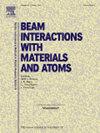Study of TID & dose rate effect of gamma radiation on COTS CMOS camera
IF 1.4
3区 物理与天体物理
Q3 INSTRUMENTS & INSTRUMENTATION
Nuclear Instruments & Methods in Physics Research Section B-beam Interactions With Materials and Atoms
Pub Date : 2025-04-14
DOI:10.1016/j.nimb.2025.165700
引用次数: 0
Abstract
Commercially available CMOS cameras suffer from gamma radiation-induced total ionizing dose (TID) effect and transient effect in nuclear surveillance applications where radiation dose is very high. TID effects are those observable effects that do not disappear soon after the removal of the radiation source, whereas transient effects appear after the incident of gamma photons and the camera returns to a normal state soon. In this paper, we have presented gamma irradiation results of CMOS APS cameras using a Co-60 source. We have investigated the TID effect on the transient response of CMOS cameras due to gamma radiation. We have irradiated a camera at three different dose rates with a TID of 37 krad and another camera at 10 krad/hr for 40 krad TID. We have used image analysis techniques to find the TID effect and the transient effect. First, we have presented the TID effect due to gamma irradiation. Subsequently, we have presented the dose rate effect of gamma radiation and discussed the TID effect on the dose rate dependent transient response of the cameras. We have observed an increase in dark signal, dark signal non-uniformity and temporal noise as the TID effect and the snow effect as a transient effect. We have not found an observable effect on the transient response of the camera due to TID. The analysis techniques and results presented in this paper are useful in applications where cameras are used as radiation monitors, in surveillance and remote inspection applications.
研究伽马辐射对 COTS CMOS 相机的 TID 和剂量率影响
市售CMOS相机在辐射剂量非常高的核监测应用中存在γ辐射诱导的总电离剂量效应和瞬态效应。TID效应是指在去除辐射源后不会很快消失的可观测效应,而瞬态效应是在伽马光子入射后出现的,相机很快就会恢复正常状态。在本文中,我们介绍了使用Co-60源的CMOS APS相机的伽马辐射结果。我们研究了伽玛辐射对CMOS相机瞬态响应的影响。我们以三种不同的剂量率照射一台相机,其TID为37克拉,另一台相机以10克拉/小时照射,TID为40克拉。我们利用图像分析技术找到了TID效应和瞬态效应。首先,我们介绍了伽马辐射引起的TID效应。随后,我们提出了伽马辐射的剂量率效应,并讨论了TID对相机剂量率相关瞬态响应的影响。我们观察到暗信号的增加,暗信号的不均匀性和时间噪声作为TID效应和雪效应作为瞬态效应。我们没有发现由于TID对相机的瞬态响应有明显的影响。本文提出的分析技术和结果可用于摄像机作为辐射监测仪、监视和远程检测应用。
本文章由计算机程序翻译,如有差异,请以英文原文为准。
求助全文
约1分钟内获得全文
求助全文
来源期刊
CiteScore
2.80
自引率
7.70%
发文量
231
审稿时长
1.9 months
期刊介绍:
Section B of Nuclear Instruments and Methods in Physics Research covers all aspects of the interaction of energetic beams with atoms, molecules and aggregate forms of matter. This includes ion beam analysis and ion beam modification of materials as well as basic data of importance for these studies. Topics of general interest include: atomic collisions in solids, particle channelling, all aspects of collision cascades, the modification of materials by energetic beams, ion implantation, irradiation - induced changes in materials, the physics and chemistry of beam interactions and the analysis of materials by all forms of energetic radiation. Modification by ion, laser and electron beams for the study of electronic materials, metals, ceramics, insulators, polymers and other important and new materials systems are included. Related studies, such as the application of ion beam analysis to biological, archaeological and geological samples as well as applications to solve problems in planetary science are also welcome. Energetic beams of interest include atomic and molecular ions, neutrons, positrons and muons, plasmas directed at surfaces, electron and photon beams, including laser treated surfaces and studies of solids by photon radiation from rotating anodes, synchrotrons, etc. In addition, the interaction between various forms of radiation and radiation-induced deposition processes are relevant.

 求助内容:
求助内容: 应助结果提醒方式:
应助结果提醒方式:


